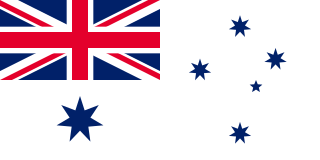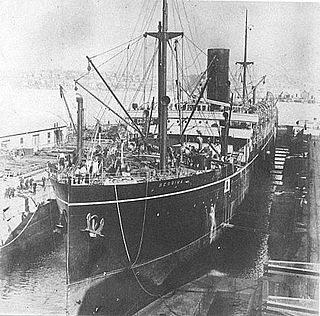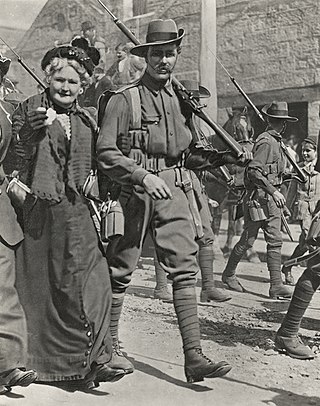Related Research Articles

The Royal Australian Navy (RAN) is the naval branch of the Australian Defence Force (ADF). The professional head of the RAN is Chief of Navy (CN) Vice Admiral Mark Hammond. The Chief of Navy is also jointly responsible to the Minister for Defence (MINDEF) and the Chief of the Defence Force (CDF). The Department of Defence, which is a part of the Australian Public Service, administers the ADF, and ergo, the Royal Australian Navy. In 2023, the Surface Fleet Review was introduced to outline the future of the Navy.

HMAS AE2 was an E-class submarine of the Royal Australian Navy (RAN). One of two submarines ordered for the fledgling navy, AE2 was built by Vickers Armstrong in England and was commissioned into the RAN in 1914. Together with her sister submarine, HMAS AE1, the boat then sailed to Australia in what was, at the time, the longest voyage ever undertaken by a submarine.

HMAS Sydney was a Chatham-class light cruiser of the Royal Australian Navy (RAN). Laid down in 1911 and launched in 1912, the cruiser was commissioned into the RAN in 1913.

HMAS Hobart was a modified Leander-class light cruiser which served in the Royal Australian Navy (RAN) during World War II. Originally constructed for the Royal Navy as HMS Apollo, the ship entered service in 1936, and was sold to Australia two years later. During the war, Hobart was involved in the evacuation of British Somaliland in 1940, fought at the Battle of the Coral Sea and supported the amphibious landings at Guadalcanal and Tulagi in 1942. She was torpedoed by a Japanese submarine in 1943, then returned to service in 1945 and supported the landings at Tarakan, Wewak, Brunei, and Balikpapan. Hobart was placed in reserve in 1947, but plans to modernise her and return her to service as an aircraft carrier escort, training ship, or guided missile ship were not followed through. The cruiser was sold for scrapping in 1962.

HMAS Australia was one of three Indefatigable-class battlecruisers built for the defence of the British Empire. Ordered by the Australian government in 1909, she was launched in 1911, and commissioned as flagship of the fledgling Royal Australian Navy (RAN) in 1913. Australia was the only capital ship to serve in the RAN.

The Battle of the Coral Sea, a major engagement of the Pacific Theatre of World War II, was fought 4–8 May 1942 in the waters east of New Guinea and south of the Bismarck Islands between elements of the Imperial Japanese Navy and Allied naval and air forces from the United States (U.S.) and Australia.

The Australian Naval and Military Expeditionary Force (AN&MEF) was a small volunteer force of approximately 2,000 men, raised in Australia shortly after the outbreak of World War I to seize and destroy German wireless stations in German New Guinea in the south-west Pacific. The German wireless installations were ordered to be destroyed because they were used by Vizeadmiral Maximilian von Spee's East Asia Squadron of the Imperial German Navy, which threatened merchant shipping in the region. Following the capture of German possessions in the region, the AN&MEF provided occupation forces for the duration of the war. New Zealand provided a similar force for the occupation of German Samoa.

The German East Asia Squadron was an Imperial German Navy cruiser squadron which operated mainly in the Pacific Ocean between the mid-1890s until 1914, when it was destroyed at the Battle of the Falkland Islands. It was based at Germany's Jiaozhou Bay Leased Territory in China.

TSS Kanowna, was an Australian steamer built during 1902. The 6,993-ton, 126-metre (413 ft) long Kanowna was constructed by William Denny and Brothers of Dumbarton, Scotland, and had a twin screw design.

There was considerable Axis naval activity in Australian waters during the Second World War, despite Australia being remote from the main battlefronts. German and Japanese warships and submarines entered Australian waters between 1940 and 1945 and attacked ships, ports and other targets. Among the best-known attacks are the sinking of HMAS Sydney by a German raider in November 1941, the bombing of Darwin by Japanese naval aircraft in February 1942, and the Japanese midget submarine attack on Sydney Harbour in May 1942. About 40 Allied merchant ships were damaged or sunk off the Australian coast by surface raiders, submarines and mines. Japanese submarines also shelled three Australian ports and submarine-based aircraft flew over several Australian capital cities.

During World War I, conflict on the Asian continent and the islands of the Pacific included naval battles, the Allied conquest of German colonial possessions in the Pacific Ocean and China, the anti-Russian Central Asian revolt of 1916 in Russian Turkestan and the Ottoman-supported Kelantan rebellion in British Malaya. The most significant military action was the careful and well-executed Siege of Qingdao in China, but smaller actions were also fought at Bita Paka and Toma in German New Guinea.

The history of the Royal Australian Navy traces the development of the Royal Australian Navy (RAN) from the colonisation of Australia by the British in 1788. Until 1859, vessels of the Royal Navy made frequent trips to the new colonies. In 1859, the Australia Squadron was formed as a separate squadron and remained in Australia until 1913. Until Federation, five of the six Australian colonies operated their own colonial naval force, which formed on 1 March 1901 the Australian Navy's (AN) Commonwealth Naval Force which received Royal patronage in July 1911 and was from that time referred to as Royal Australian Navy (RAN). On 4 October 1913 the new replacement fleet for the foundation fleet of 1901 steamed through Sydney Heads for the first time.

HMAS Berrima was a passenger liner which served in the Royal Australian Navy (RAN) during World War I as an armed merchantman and troop transport. Launched in 1913 as the P&O liner SS Berrima, the ship initially carried immigrants from the United Kingdom to Australia via Cape Town. In August 1914, Berrima was requisitioned for military use, refitted and armed, and commissioned into the RAN as an auxiliary cruiser. The ship transported two battalions of the Australian Naval and Military Expeditionary Force to the German New Guinea colonies in September.

The Battle of Bita Paka was fought south of Kabakaul, on the island of New Britain, and was a part of the invasion and subsequent occupation of German New Guinea by the Australian Naval and Military Expeditionary Force (AN&MEF) shortly after the outbreak of the First World War. Similar to New Zealand's operation against German Samoa in August, the main target of the operation was a strategically important wireless station—one of several used by the German East Asia Squadron—which the Australians believed to be located in the area. The powerful German naval fleet threatened British interests and its elimination was an early priority of the British and Australian governments during the war.

HMCSProtector was a large flat-iron gunboat commissioned and purchased by the South Australian government in 1884, for the purpose of defending the local coastline against possible attacks in the aftermath of the 'Russian scare', of the 1870s. She arrived in Adelaide in September 1884 and served in the Boxer Rebellion, World War I and World War II.

The Occupation of Samoa was the takeover – and subsequent administration – of the Pacific colony of German Samoa by New Zealand during World War I. It started in late August 1914 with landings by the Samoa Expeditionary Force from New Zealand. The landings were unopposed and the New Zealanders took possession of Samoa for the New Zealand Government on behalf of King George V. The Samoa Expeditionary Force remained in the country until 1915, while its commander, Colonel Robert Logan, continued to administer Samoa on behalf of the New Zealand Government until 1919. The takeover of Samoa was New Zealand's first military action in World War I.

Task Force 44 was an Allied naval task force during the Pacific Campaign of World War II. The task force consisted of warships from the United States Navy and the Royal Australian Navy (RAN). It was generally assigned as a striking force to defend northeast Australia and the surrounding area from any attacks by Axis forces, particularly from the Empire of Japan.

The Samoa Expeditionary Force (SEF) was a small volunteer force of approximately 1,400 men raised in New Zealand shortly after the outbreak of World War I to seize and destroy the German wireless station in German Samoa in the south-west Pacific. Britain required the German wireless installations to be destroyed because they were used by Vizeadmiral Maximilian von Spee's East Asia Squadron of the Imperial German Navy, which threatened merchant shipping in the region. Following the capture of German possessions in the region, the SEF provided occupation forces for the duration of the war. Australia provided a similar force for the Allied occupation of German New Guinea.

The convoy—a group of merchantmen or troopships traveling together with a naval escort—was revived during World War I (1914–18), after having been discarded at the start of the Age of Steam. Although convoys were used by the Royal Navy in 1914 to escort troopships from the Dominions, and in 1915 by both it and the French Navy to cover their own troop movements for overseas service, they were not systematically employed by any belligerent navy until 1916. The Royal Navy was the major user and developer of the modern convoy system, and regular transoceanic convoying began in June 1917. They made heavy use of aircraft for escorts, especially in coastal waters, an obvious departure from the convoy practices of the Age of Sail.

The Allied occupation of German New Guinea was the takeover of the Pacific colony of German New Guinea in September – November 1914 by an expeditionary force from Australia, called the Australian Naval and Military Expeditionary Force.
References
This article includes a list of references, related reading, or external links, but its sources remain unclear because it lacks inline citations .(August 2015) |
- MacKenzie, Seaforth (1941). The Australians at Rabaul: The Capture and Administration of the German Possessions in the South Pacific. Official History of Australia in the War of 1914–1918, Volume X. (Tenth ed.). Canberra, Australian Capital Territory: Australian War Memorial. OCLC 494426919.